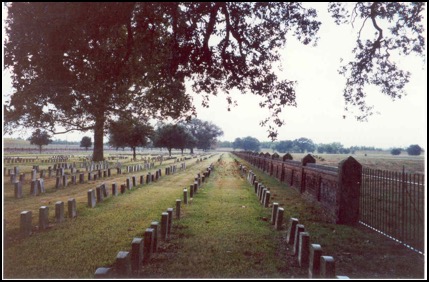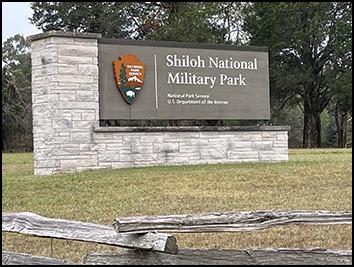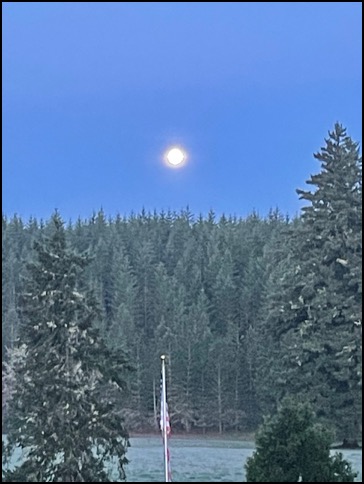February 2024
Chalmette Battlefield Next
27/02/24 11:07 Filed in: History
Another one of the six battlefields one can visit and we have is in Louisiana, just outside New Orleans…
Located downriver from New Orleans, Chalmette Battlefield was the site of the last great battle of the War of 1812, fought between the U.S. and Great Britain. Although the Treaty of Ghent was signed in late 1814, the war continued. On January 8, 1815, General Andrew Jackson assembled troops from across Louisiana and the southeastern U.S. to defeat the British military and prevent them from gaining control of a critical port on the Mississippi River. The Battle of New Orleans was hailed as the final victory in the “Second War of Independence,” and for decades it was celebrated as a national holiday, much like the Fourth of July. A visit to Chalmette Battlefield offers the chance to walk in the footsteps of General Jackson (who went on to become the seventh U.S. President) and his troops. It contains a reconstructed American rampart, an original home from the 1830s, and the stunning,100-foot-high Chalmette Monument. Delve further into the history of the battle site via films and exhibits at the visitor center, where you’ll find outdoor exhibits, self-guided tours, and daily ranger talks. Also of interest is Chalmette National Cemetery: Established during the Civil War in 1864, it shelters more than 14,000 graves of Americans, dating from the War of 1812 to the Vietnam War.

Located downriver from New Orleans, Chalmette Battlefield was the site of the last great battle of the War of 1812, fought between the U.S. and Great Britain. Although the Treaty of Ghent was signed in late 1814, the war continued. On January 8, 1815, General Andrew Jackson assembled troops from across Louisiana and the southeastern U.S. to defeat the British military and prevent them from gaining control of a critical port on the Mississippi River. The Battle of New Orleans was hailed as the final victory in the “Second War of Independence,” and for decades it was celebrated as a national holiday, much like the Fourth of July. A visit to Chalmette Battlefield offers the chance to walk in the footsteps of General Jackson (who went on to become the seventh U.S. President) and his troops. It contains a reconstructed American rampart, an original home from the 1830s, and the stunning,100-foot-high Chalmette Monument. Delve further into the history of the battle site via films and exhibits at the visitor center, where you’ll find outdoor exhibits, self-guided tours, and daily ranger talks. Also of interest is Chalmette National Cemetery: Established during the Civil War in 1864, it shelters more than 14,000 graves of Americans, dating from the War of 1812 to the Vietnam War.

Comments
Six Must See Battlefields
26/02/24 18:02 Filed in: History
While reading through a Daily Passport email, one of their story leads was about six must-see battlefields in the United States. We have visited all six at some point. I will start with the last one we visited last October, Shiloh Battlefield, located in southern Tennessee just over the Tennessee-Mississippi border. The largest loss of life in a battle in the U.S. and in some respects a draw between the Union and Rebel forces.
From the article:
The Battle of Shiloh, also known as the Battle of Pittsburg Landing, was one of the most significant battles in the Mississippi Valley Campaign of the Civil War. The Union’s victory on April 7, 1862, came at a high cost, resulting in more casualties than in all of America’s previous wars combined. Occupying over 5,000 acres, Shiloh National Military Park offers visitors the chance to discover several historic sites. These include the Corinth Battlefield Unit, which preserves the Siege and Battle of Corinth, and the Shiloh National Cemetery, the resting place of around 4,000 fallen soldiers. Also found here are the Shiloh Indian Mounds, an archeological remnant of the South Appalachian Mississippi culture that lived in the area around 1200 CE. A great way to explore the park is by driving its 12.7-mile, 22-stop self-guided tour of the battlefield. Alternatively, visitors can hike along trails or ride a bicycle or e-bike around the paved roads. Whichever way you get around, you’ll get the chance to spot local wildlife, including 186 bird species, such as the majestic bald eagle and great-horned owl.

From the article:
The Battle of Shiloh, also known as the Battle of Pittsburg Landing, was one of the most significant battles in the Mississippi Valley Campaign of the Civil War. The Union’s victory on April 7, 1862, came at a high cost, resulting in more casualties than in all of America’s previous wars combined. Occupying over 5,000 acres, Shiloh National Military Park offers visitors the chance to discover several historic sites. These include the Corinth Battlefield Unit, which preserves the Siege and Battle of Corinth, and the Shiloh National Cemetery, the resting place of around 4,000 fallen soldiers. Also found here are the Shiloh Indian Mounds, an archeological remnant of the South Appalachian Mississippi culture that lived in the area around 1200 CE. A great way to explore the park is by driving its 12.7-mile, 22-stop self-guided tour of the battlefield. Alternatively, visitors can hike along trails or ride a bicycle or e-bike around the paved roads. Whichever way you get around, you’ll get the chance to spot local wildlife, including 186 bird species, such as the majestic bald eagle and great-horned owl.

Early Morning Moonset and Sunrise
24/02/24 07:22 Filed in: Photography | Berlin
This morning was the apex of the full "snow" moon of February while at the same time we had a colorful sunrise.
To the west:

To the east:

To the west:

To the east:

Post Presidency-Theodore Roosevel
20/02/24 19:17 Filed in: History
President's Holiday was just yesterday. I did not get a post written. I plan to catch up today in posting about Theodore Roosevelt. He was a President who had an interesting and active life before and after his Presidency. This is information from History Facts.
"Theodore Roosevelt was never a man to sit on the sidelines twiddling his thumbs. Following his disappointing loss to Woodrow Wilson in the 1912 presidential election (which would have given Roosevelt a third term in office), the 55-year-old decided to embark upon a dangerous expedition down an uncharted tributary of the Brazilian Amazon called the Rio da Dúvida, or River of Doubt. Accompanied by his 23-year-old son Kermit and a team of porters, explorers, and scientists, Roosevelt set off in December 1913. By the time they reached the River of Doubt in February 1914, they had already lost a number of team members to tropical illnesses, and half their pack animals had died. As they ventured farther down the unmapped territory, they had to contend with everything from mosquitoes to alligators to the potential threat of attack from Indigenous peoples in the area. Roosevelt got malaria during the lengthy expedition, and became dangerously ill. Still, the team managed to reach the end of their journey, at which point Roosevelt sent an understated telegram describing it as “a hard and somewhat dangerous, but very successful trip.”
"Theodore Roosevelt was never a man to sit on the sidelines twiddling his thumbs. Following his disappointing loss to Woodrow Wilson in the 1912 presidential election (which would have given Roosevelt a third term in office), the 55-year-old decided to embark upon a dangerous expedition down an uncharted tributary of the Brazilian Amazon called the Rio da Dúvida, or River of Doubt. Accompanied by his 23-year-old son Kermit and a team of porters, explorers, and scientists, Roosevelt set off in December 1913. By the time they reached the River of Doubt in February 1914, they had already lost a number of team members to tropical illnesses, and half their pack animals had died. As they ventured farther down the unmapped territory, they had to contend with everything from mosquitoes to alligators to the potential threat of attack from Indigenous peoples in the area. Roosevelt got malaria during the lengthy expedition, and became dangerously ill. Still, the team managed to reach the end of their journey, at which point Roosevelt sent an understated telegram describing it as “a hard and somewhat dangerous, but very successful trip.”
Lopsided Buck Antlers
18/02/24 14:04 Filed in: Animal Kingdom
One of our visiting bucks at a prior time demonstrated a lopsided look with this antlers. I wonder what happened? A fight with another buck or with a tree? We shall see…


What Friendship Means
12/02/24 19:25 Filed in: History
Today is Abraham Lincoln's birthday and part of the upcoming federal holiday of President's Day which is shared with another special President, George Washington.
This column shares how Lincoln had a gift for friendship that carried him into greatness and the Presidency. How special is it to have friends who could be your enemy yet see a potential rival as a best friend. It is wonderful to have such support in life.
"His genius for friendship manifested itself in memorable ways. As a young man, for example, Lincoln’s physical stature and strength made him a formidable wrestler. He made friends by wrestling, although this was not the kind of wrestling that is a branch of show business or in which the outcome of the match is agreed upon by the contestants in advance."
This column shares how Lincoln had a gift for friendship that carried him into greatness and the Presidency. How special is it to have friends who could be your enemy yet see a potential rival as a best friend. It is wonderful to have such support in life.
"His genius for friendship manifested itself in memorable ways. As a young man, for example, Lincoln’s physical stature and strength made him a formidable wrestler. He made friends by wrestling, although this was not the kind of wrestling that is a branch of show business or in which the outcome of the match is agreed upon by the contestants in advance."
Snow Moon February 24
11/02/24 14:17 Filed in: Culture
The full moon for February will fall on February 24th, early in the morning. The February full moon is called the Snow Moon. Why?
Native Americans in South Dakota called the moon as such since February would often get more snow than other winter months.
Also, Eleven months in the calendar year have at least one full moon—and sometimes even two—occurring in the same month. February is the one oddball exception to that rule. For as we know, it’s the shortest month of the year and, even more oddly, sports an extra day on leap years.Thus, very rarely, just once every 19 years, there will be no full moons in February. One will appear right before and one right after, but the full moon will slip right by February itself, continuing along its tour of the calendar year like nothing happened. This happenstance is what’s called a “dark moon.” The last dark moon was in February 2018. We will not see another until 2037.
Native Americans in South Dakota called the moon as such since February would often get more snow than other winter months.
Also, Eleven months in the calendar year have at least one full moon—and sometimes even two—occurring in the same month. February is the one oddball exception to that rule. For as we know, it’s the shortest month of the year and, even more oddly, sports an extra day on leap years.Thus, very rarely, just once every 19 years, there will be no full moons in February. One will appear right before and one right after, but the full moon will slip right by February itself, continuing along its tour of the calendar year like nothing happened. This happenstance is what’s called a “dark moon.” The last dark moon was in February 2018. We will not see another until 2037.
State Site Pronunciations
09/02/24 13:52 Filed in: Oregon
I was born and raised in a state where many of the place names are Native American based. My home town is often mispronounced, LebaNON is said, and it is LebaNUN. Along with how Oregon is constantly mispronounced. I can always tell who is not a local, born and bred.
Not Ore-uh-GON. Some say "It’s pronounced OR-aginn' or I will say "OR-e-gun' just automatically running together.
Other spots in Oregon that get mispronounced are…
Heceta Head Lighthouse
Champoeg State Park
Ankeny National Wildlife Refuge
Not Ore-uh-GON. Some say "It’s pronounced OR-aginn' or I will say "OR-e-gun' just automatically running together.
Other spots in Oregon that get mispronounced are…
Heceta Head Lighthouse
Champoeg State Park
Ankeny National Wildlife Refuge
- Deschutes (Somebody on Reddit said they heard it pronounced Day-SKOOT-taze
- Willamette (pronounced w’LAMMIT, not w’LAMMITEE or WILL-uh-met))
- Tigard (tiger’d)
- Lake Oswego
- Glisan (pronounced “Gleesin)
- Helvetia (Hint: It’s not Helvetica; that is a font!)
- Tualatin (It’s not Tua-LATE-in)
- Yachats (Yak-Hats)
- The Dalles (Please don’t call it The Dallas)
- Aloha (pronounced Uh-LOWuh)\
- Coquille (pronounced Ko-KEEL)

